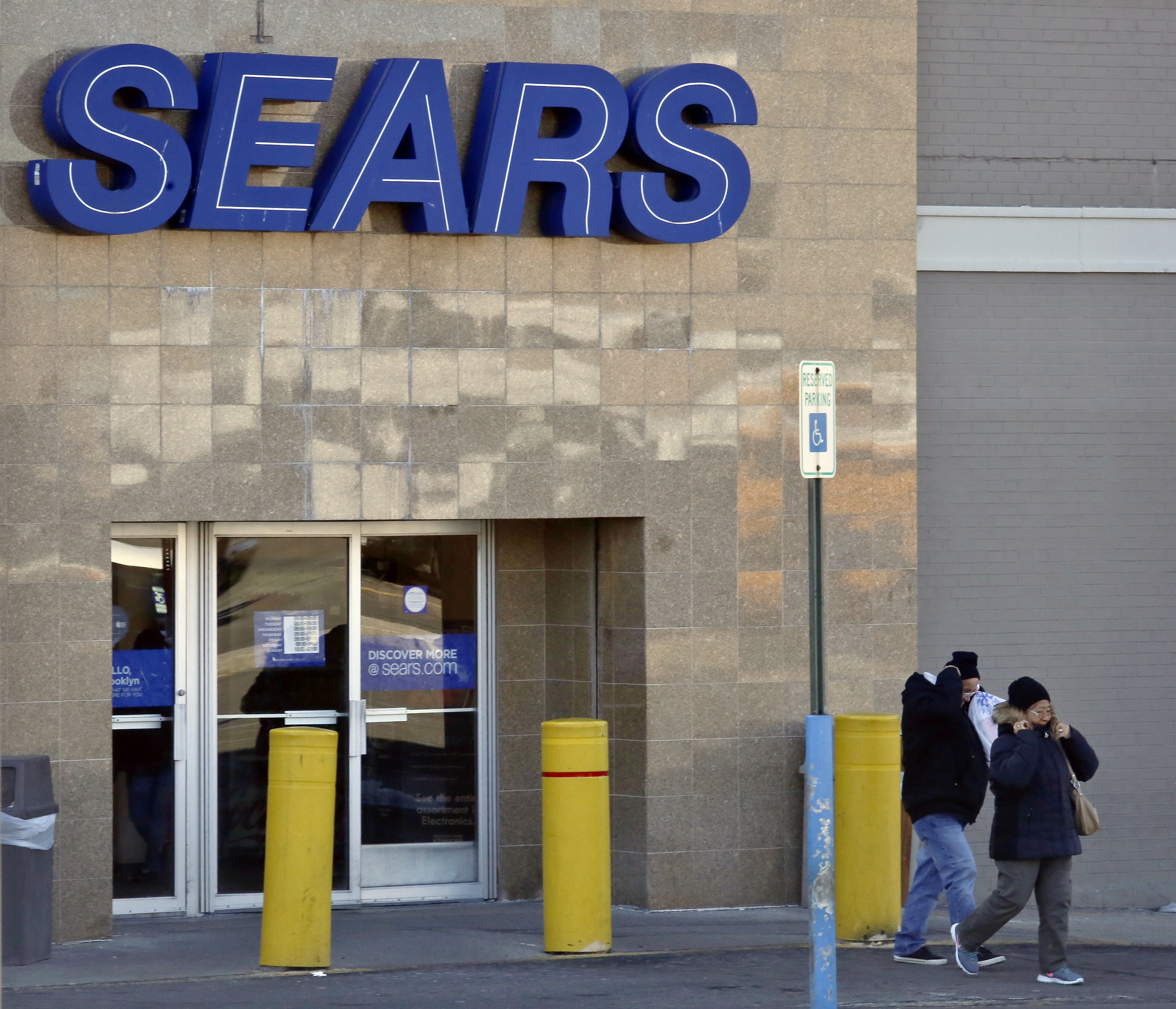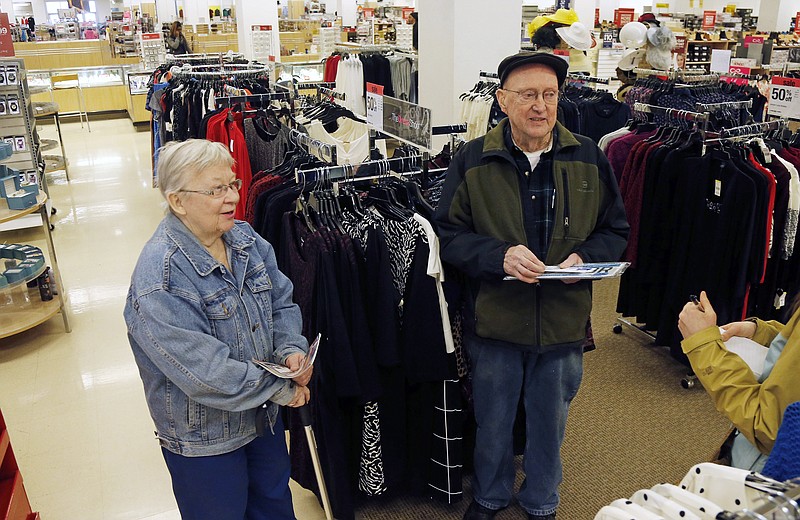 People walk out of a Sears department store in Brooklyn's Flatbush neighborhood, Wednesday, March 22, 2017, in New York. Sears, once the monolith of American retail, says that there is "substantial doubt" that it will be able to keep its doors open. Company shares tumbled more than 12 percent Wednesday. (AP Photo/Bebeto Matthews)
People walk out of a Sears department store in Brooklyn's Flatbush neighborhood, Wednesday, March 22, 2017, in New York. Sears, once the monolith of American retail, says that there is "substantial doubt" that it will be able to keep its doors open. Company shares tumbled more than 12 percent Wednesday. (AP Photo/Bebeto Matthews)CBL falls to 7-year low
Shares of CBL & Associated Properties Inc., the fourth largest shopping mall real estate investment trust, fell Wednesday by another 4.9 percent, or 46 cents per share, to close at $8.93 per share — its lowest price in seven years. In a report headlined “The retail apocalypse has officially descended on America,” Business Insider tallied more than 3,500 retail stores that will close in the next couple of months, including many in shopping malls across the country due to cutbacks by JCPenney, Macy’s, Crocs, BCBG, Abercrombie & Fitch, Guess, Sears and Kmart.
Closer to home
› Sears operates department stores in the Hamilton Place Mall in East Brainerd, the Northgate Mall in Hixson and the Walnut Square Mall in Dalton, Ga.› Kmart operates stores in Fort Oglethorpe, Dalton, Calhoun and Rome, Ga., and in Tullahoma, Cookeville and Crossville, Tenn.
More Info
Sears got its start more than 130 years ago as a mail-order watch seller. It grew to become the world’s largest retailers. But today, it is struggling. It has been closing stores to fight falling sales and this week said it has “substantial doubt ” that it can stay in business.Here’s a look at Sears through the years:1886 — Richard Sears starts the R.W. Sears Watch Co. in Minneapolis.1888 — The Sears catalog is born, featuring watches and jewelry. By 1894, sewing machines, baby carriages and other items are added.1893 — The company becomes Sears, Roebuck and Co.1906 — Sears becomes a public company.1913 — Sears launches the Kenmore brand of sewing machines. Today, refrigerators, washing machines and other appliances are sold under the name.1925 — The first Sears brick-and-mortar store opens in Chicago.1927 — Sears buys the Craftsman trademark for $500 and begins to sell power tools under the brand about two years later. In 2017, it announced plans to sell the brand to Stanley Black & Decker Inc. in a $900 million deal.1931 — Allstate Insurance Co. is launched, offering auto insurance. Sears sold its stake and Allstate became an independent company in the 1990s.1973 — The company finishes building its new headquarters, the Sears Tower in Chicago. At time, it was the world’s tallest building at 1,454 feet tall. Sears sold the Chicago landmark in 1994. Its current headquarters are in Hoffman Estates, Illinois.1985 — The Discover Card is introduced nationally. Sears spun off a financial company in the 1990s which included the card.1993 — Sears stops sending its famous catalog.2005 — Kmart buys Sears and the company becomes the Sears Holdings Corp.2017 — The company announces plans to cut $1 billion in costs by selling more store locations, cutting more jobs and putting more of its famous brands on the block.———Sources: Sears, AP archives
Sears, a back-to-school shopping destination for generations of kids and the place newlyweds went to choose appliances, has said that after years of losing money there is "substantial doubt" it will be able to keep its doors open.
It's a dramatic acknowledgment from the chain that owns Sears and Kmart stores, which has long held fast to its stance that a turnaround is possible, even as many of its shoppers have moved on to Wal-Mart, Target or Amazon.
Sears has survived of late mainly with millions in loans funneled through the hedge fund of Chairman and CEO Edward Lampert, but with sales fading it is burning through cash. Sears Holdings Corp. said late Tuesday it lost more than $2 billion last year, and its historical operating results indicated doubt about the future of the company that started in the 1880s as a mail-order catalog business.
At a largely empty Sears store in St. Paul, Minn., where the available parking far outstripped the number of cars in the lot, 85-year-old Jack Walsh and his 82-year-old wife, Mary Ann, said they have shopped at Sears their entire lives, buying items from curtains and window treatments to tires and tools.
"I bought my tools from Sears and I've still got them," Jack Walsh said.
The company known for DieHard batteries and Kenmore appliances has been selling assets, most recently its Craftsman tool brand. But it says pension agreements may prevent the sale of more businesses, potentially leading to a shortfall in funding.
"It's a sad story. This is the place that created the first direct to consumer retail, the first modern department store. It stood like the Colossus over the American retail landscape," said Craig Johnson, president of Customer Growth Partners, a retail consulting firm. "But it's been underinvested and bled dry."
Company shares, which hit an all-time low last month, tumbled more than 12.3 percent Wednesday. Sears tried to soothe investors' fears, saying in a post on its site that it remains focused on "executing our transformation plan" and that news reports miss the full disclosure that it's highlighting actions to reduce risks. It also said the comments made in the filing were in line with "regulatory standards."
Lampert combined Sears and Kmart in 2005, about two years after he helped bring Kmart out of bankruptcy. He pledged to return Sears to greatness, leveraging its best-known brands and its vast holdings of land, and more recently planned to entice customers with its loyalty program. The company, which employs 140,000 people, announced in January it would close 108 additional Kmart and 42 more Sears locations, and unveiled yet another restructuring plan in February aimed at cutting costs and reconfiguring debts to give itself more breathing room.
But it has to get more people through the doors or shopping online for what it's selling. Sears, like many department stores, has been thwarted by a new consumer that has ripped up the decades-old playbook the industry has relied upon. A plethora of new online players have also revolutionized the market.
Sears has upped its presence online, but is having a hard time disguising its age. Its stores are in need of a major refresh as rivals like Wal-Mart and Target invest heavily to revitalize stores. Sales at established Sears and Kmart locations dropped 10.3 percent in the final quarter of 2016.
Industry analysts have placed the staggering sums of money Sears is losing beside the limited number of assets it has left to sell, and believe the storied retailer may have reached the point of no return.
The company has lost $10.4 billion since 2011, the last year it made a profit. Excluding charges that can be listed as one-time events, the loss is $4.57 billion, said Ken Perkins, who heads the research firm Retail Metrics LLC, but how the losses are stacked no longer seems to matter.
"They're past the tipping point," Perkins said. "This is a symbolic acknowledgement of the end of Sears of what we know it to be."
For Sears to survive, Perkins believes it would need to do so as a company running maybe 200 stores. It now operates 1,430, a figure that has been vastly reduced in recent years. As for Kmart, Perkins does not see much of a future.
For decades, Sears was king of the American shopping landscape. Sears, Roebuck and Co.'s storied catalog featured items from bicycles to sewing machines to houses, and could generate excitement throughout a household when it arrived. The company began opening retail locations in 1925 and expanded swiftly in suburban malls from the 1950s to 1970s.
"When I first got married at 19 or 20, we bought our first set of kettles from Sears," said Darla Klemmensen, who was shopping at the St. Paul store on Wednesday. "We still have some of those."
Klemmensen says Sears has been part of her life since she was a child watching her grandmother order stockings and garters, and she remembers flipping through Sears catalogs as thick as her forearm, full of appliances, clothing and kitchen wares.
But the onset of discounters like Wal-Mart created challenges for Sears that have only grown. Sears faced even more competition from online sellers and appliance retailers like Lowe's and Home Depot. Its stores became its albatross, many of them looking shabby and outdated. The company, based northwest of Chicago in Hoffman Estates, Illinois, lost $607 million in the most recent quarter and revenue fell.
"They've been delusional about their ability to turn around the business," said Perkins.
Johnson, though, believes one avenue for Sears could be returning to its roots as a direct-to-consumer company, only using the internet versus the old catalog. He believes the Sears name still stands for something for the 40-plus customer.
"It has a lot of good memories," he said. "It stands for being dependable and reliable."
